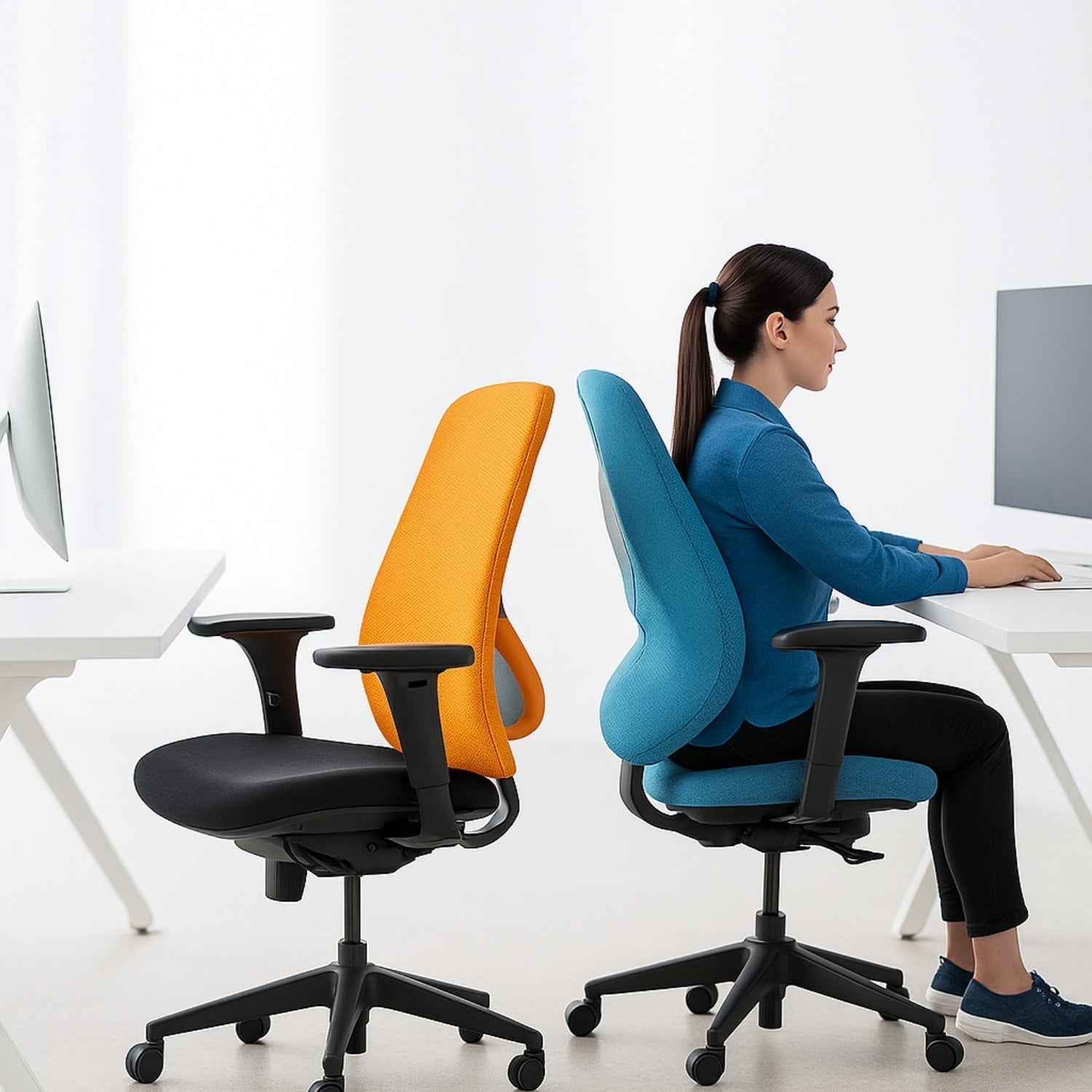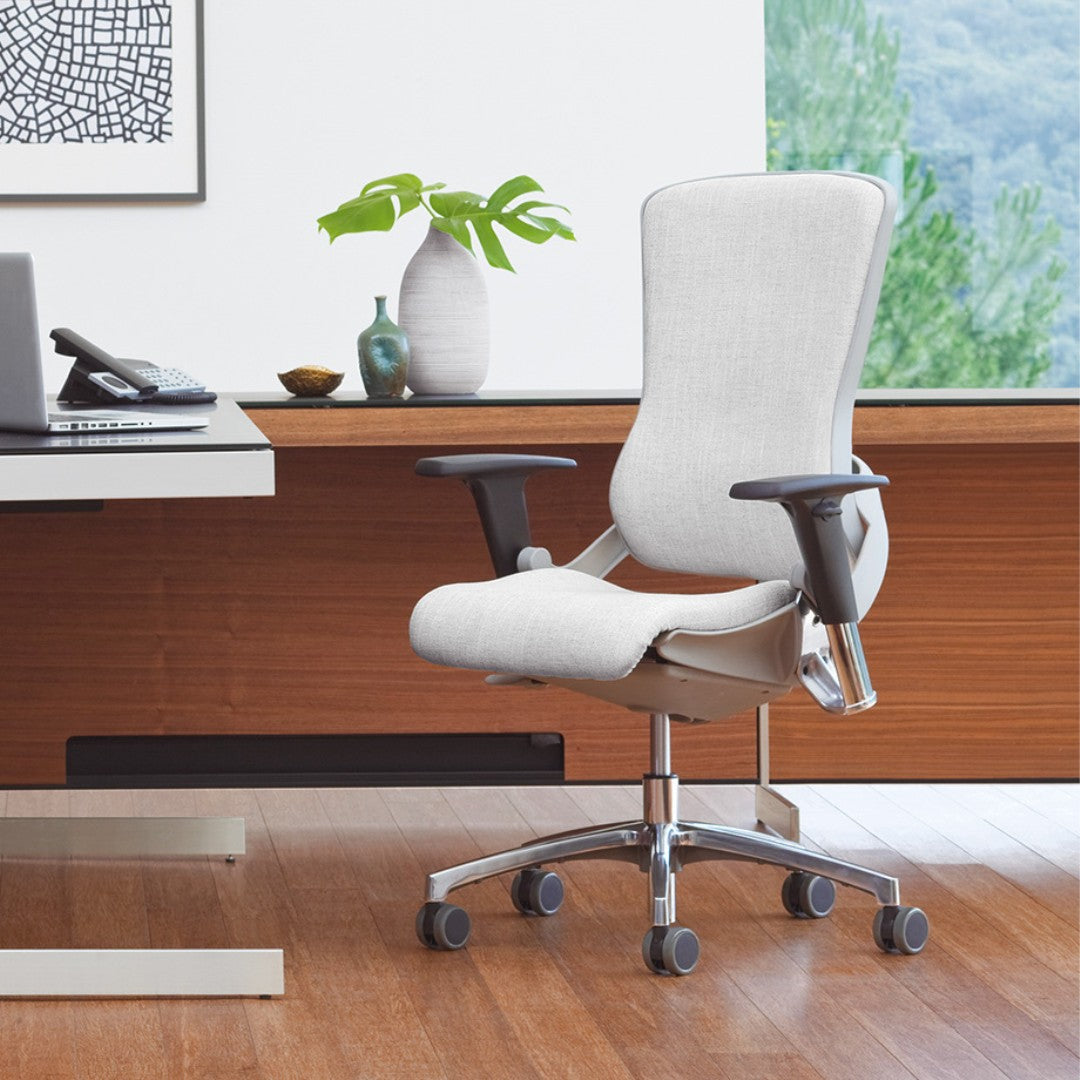
Introduction to Office Ergonomics
Office ergonomics is not just about comfort—it’s a critical discipline that blends science and design to adapt the workplace to the needs of its users, aiming to enhance health, comfort, and efficiency. In the modern workplace, where many individuals spend the majority of their day seated at a desk, understanding and implementing ergonomic principles is not just beneficial; it's essential for preventing a myriad of occupational injuries and health issues such as chronic back pain, carpal tunnel syndrome, and repetitive strain injuries.
This comprehensive guide dives deep into the world of office ergonomics, highlighting the profound impact that a well-designed workspace can have on productivity and well-being. We'll begin by exploring the central role of the office chair—an often overlooked but fundamental element of ergonomic practice. The right chair can not only prevent pain and discomfort but also enhance job performance by fostering better posture and reducing unnecessary strain on the body.
Beyond the chair, this guide will cover additional vital components of a well-rounded ergonomic workspace. We'll discuss the optimal placement of monitors, which can prevent neck and eye strain, and the importance of desk organization to maintain a workflow that minimizes stress and maximizes efficiency. Keyboard and mouse positioning will also be addressed, focusing on how proper alignment can prevent the aches and pains associated with long hours of typing and clicking.
Moreover, we recognize that ergonomics is not solely about equipment and furniture placement but also about behavior. Regular breaks, movement exercises, and stretching are integral to maintaining musculoskeletal health and overall energy levels. We'll provide practical tips for integrating these habits into your workday, ensuring that you can stay productive without compromising your health.
By the end of this guide, you'll be equipped with the knowledge to assess and optimize your office setup, leading to a more comfortable, productive, and healthy work environment. Whether you are outfitting a corporate office or a small home desk, these principles of office ergonomics will empower you to make informed decisions that enhance your work life.
The Role of the Office Chair in Enhancing Office Ergonomics
In the realm of office ergonomics, the choice of an office chair is a pivotal decision in setting up an ergonomic workspace. With many professionals spending significant portions of their day seated, the office chair transcends its role as a mere piece of furniture to become a critical tool for maintaining health and enhancing productivity.
For a vast number of workers today, the office is a place where long hours are invariably spent in front of computer screens. This reality brings to light the paramount importance of a well-chosen ergonomic chair. An ill-suited chair can lead to a host of physical discomforts—ranging from minor aches to severe, chronic conditions such as lower back pain, sciatica, and carpal tunnel syndrome.
(See: 7 Health Benefits of Ergonomic Chairs)
On the other hand, a chair that is carefully selected to promote good posture and accommodate the body's movements can significantly boost work efficiency and concentration while minimizing the risk of enduring work-related injuries.
Ergonomics integrates the science of matching the workplace to the user’s needs, placing the office chair at the core of this endeavor to uphold optimal health and operational efficiency. The ideal chair should conform not only to the physical proportions of the user but also to the specific demands of their job tasks.
For example, a graphic designer might require a chair that supports a reclined position to lessen the strain from prolonged monitor viewing, whereas a writer could benefit more from a chair that encourages upright sitting, which is optimal for typing.
(See: 5 Different Types of Office Chairs)
The economic impact of selecting the right office chair also holds considerable weight. More and more employers recognize that a substantial initial investment in high-quality ergonomic chairs can result in considerable long-term benefits including reduced healthcare expenses, diminished absenteeism, and heightened productivity. Such investments often yield a high return by cultivating a more dynamic, satisfied, and healthier workforce.
Thus, selecting an office chair is a decision that demands careful consideration, not only of its ergonomic features and job-specific appropriateness but also of its broader impact on workplace wellness and productivity. This guide is designed to provide you with the essential information needed to make a well-informed choice about which office chair best suits your office ergonomics needs, ensuring that your workspace is both comfortable and conducive to productivity.
For a more in depth look into how to select the right office chair for you, check out our blog here. After learning a bit more about what it is that you need in an ergonomic chair, we recommend using our Chair Finder Tool to find chair models that match your seating needs. With this simple and quick assessment, you'll get a curated list of Office Master chairs that are most relevant for you.
Key Features to Consider
-
Adjustability: The hallmark of a truly ergonomic chair is its ability to adjust to fit the user, rather than forcing the user to fit the chair. Look for multiple adjustment features:
- Height Adjustment: Ensures that users of different statures can have their feet flat on the ground, with thighs horizontal and arms at the correct height relative to the desk.
- Backrest Adjustment: Allows the angle and height of the backrest to be changed to support the entire back, particularly the lumbar region.
-
Armrest Adjustment: Should be adjustable in height and width to accommodate different body sizes and prevent shoulder strain.
-
Lumbar Support: Essential for supporting the lower back, lumbar support helps maintain the spine’s natural curve and prevents slumping. Adjustable lumbar support that can be moved up or down as well as forward or back ensures a better fit for your spinal curvature.
-
Seat Depth and Width: The seat should be wide and deep enough to comfortably support any user. The standard rule is that the user should be able to sit with their back against the backrest while leaving about 2 to 4 inches between the back of the knees and the seat of the chair. Seat depth adjustment allows for proper distribution of weight and helps avoid pressure behind the knees.
-
Material and Padding: Comfort and durability are key. The chair should have enough padding to support prolonged sitting without discomfort. Materials should be breathable, like mesh, which prevents the buildup of heat and moisture.
-
Swivel and Mobility: A swivel base and smooth-rolling casters are important for enabling easy movement around the workspace. This functionality helps minimize strain due to reaching and twisting.
Adjusting Your Office Chair

Properly adjusting your office chair is crucial for reaping the benefits of its ergonomic design. Here’s a detailed guide on how to set up your chair:
-
Height: Your chair should be adjusted so that your feet are flat on the floor, with your knees at a right angle. This position helps maintain proper circulation and reduces pressure on your thighs.
-
Backrest: Adjust the backrest to fit the natural curve of your spine, with special attention to the lumbar region. The angle should support a slightly reclined posture, which is often less straining than sitting upright at 90 degrees.
-
Armrests: Raise or lower the armrests so they support your arms without causing you to hunch your shoulders. Proper armrest height helps alleviate pressure on your shoulders and aids in keeping your neck relaxed.
-
Seat Depth: If adjustable, set the seat depth so that you can sit with your back against the backrest without pressing the backs of your knees into the edge of the seat. This helps distribute weight evenly and supports proper leg circulation.
-
Tilt Mechanism: Utilize the tilt mechanism to allow for a range of movement. This promotes dynamic sitting, encourages blood flow, and reduces pressure points by allowing you to shift your weight periodically.
Adjusting and choosing the right office chair can significantly impact your health and comfort at work. By carefully selecting a chair that meets your needs and ensuring it is properly adjusted, you create a foundation for better posture, reduced strain, and increased productivity in the office.
Ergonomic Chair Recommendations
-
For Back Pain: Look for chairs with robust lumbar support and high adjustability to allow for a tailored fit that supports the spine correctly. Ergonomic chairs designed for back pain typically feature enhanced lumbar systems that are highly customizable.
Our recommendation: Office Master PT78

-
For Long Hours: Chairs designed for long hours of use are typically more durable and have extensive adjustable features, including seat angle, tension control, and more. They should also have high-quality padding that retains its shape and support over time.
Our recommendation: Office Master IU79HD
-
Budget-Friendly Options: There are economical choices available that still offer key ergonomic features such as basic adjustability and lumbar support. These chairs may lack some of the more advanced customization features but still provide significant improvements over traditional office chairs.
Our recommendation: Office Master YS72

The Importance of Monitor Positioning in Office Ergonomics
The strategic placement of the computer monitor is a cornerstone of effective office ergonomics. As technology increasingly dominates the modern workspace, ensuring the monitor is positioned correctly becomes essential not just for enhancing work efficiency, but also for maintaining physical health and wellbeing. The consequences of improper monitor placement can be far-reaching, affecting everything from visual acuity to overall posture, and can lead to a range of issues including eye strain, neck pain, and musculoskeletal disorders.
Ergonomics, by its nature, involves adjusting the environment to fit the needs of the user, and monitor placement is a prime example of this principle in action. It’s not merely about setting a screen at the right height or distance; it’s about creating an interaction between the digital display and the human body that promotes optimal health and functionality. The goal is to align the monitor in such a way that the body maintains a natural, neutral position while viewing the screen, minimizing stress on any particular part of the body.
In an ergonomic office setup, the position of the monitor is carefully calculated to reduce the need for excessive head tilting or frequent eye adjustments that can lead to fatigue and discomfort. The ideal position encourages a slight downward gaze, which not only eases the strain on the neck but also benefits the eyes by reducing exposure to the ambient light competing with the screen’s display. This setup is crucial for long-term comfort and can significantly impact productivity and focus.
Moreover, the economic implications of monitor ergonomics are significant. Businesses that invest in ergonomic assessments and implement changes based on those findings often see a decrease in employee health complaints, a reduction in absenteeism due to physical ailments, and an overall increase in job satisfaction and output. This investment in proper office setup, particularly monitor placement, underscores the connection between ergonomic practices and the financial health of a company.
Understanding the science behind monitor placement and its impact on the human body is essential for anyone involved in designing or setting up workspaces. This section of our guide will delve into the specifics of ideal monitor setup—detailing how to adjust your monitor for height, distance, and angle to optimize your physical health and enhance your working efficiency in an office environment.
Desk Setup and Organization

An organized and ergonomically arranged desk is another vital component of a productive and healthy office environment. Proper desk setup not only facilitates easier access to necessary tools and documents but also contributes significantly to maintaining good posture and minimizing strain during work hours.
-
Desk Height: The height of your desk should allow you to type on a keyboard with your arms relaxed and your elbows at a right angle, thereby preventing strain on your shoulders, arms, and wrists. Adjustable desks are ideal as they can be modified to meet individual ergonomic needs, including sitting and standing options.
-
Workspace Layout: Organize your desk to minimize the need to stretch or twist your body to reach essential items. Frequently used items, like your phone, notepad, or mouse, should be within easy arm's reach. This setup reduces unnecessary movement and helps maintain a neutral body posture.
-
Cable Management: Keep cables from your monitor, keyboard, mouse, and other devices organized and out of the way. Proper cable management prevents clutter, which not only helps in maintaining an organized desk but also reduces trip hazards and maintains the integrity of the equipment.
-
Document Placement: If you frequently refer to printed materials or documents while working, consider using a document holder. Place it close to the monitor at a similar height, which helps in reducing the need to twist your neck or strain your eyes moving back and forth from the document to the screen.
-
Lighting: Adequate lighting is essential to avoid eye strain. Ensure that the desk is well-lit, preferably with natural light or lamps that mimic daylight. Position lights to minimize glare on your screen, which can lead to eye fatigue.
Tips for Organizing Your Desk
-
Create Efficient Work Zones: Divide your desk into specific areas for different tasks. This could include a zone for computer work, another for writing or reading, and a space for personal items. Such segmentation can help reduce unnecessary movements and keep essential tools within easy reach.
-
Use Vertical Space: Take advantage of vertical space with shelves or stackable organizers. This can help keep your desk surface clear while ensuring that everything you need is easily accessible.
-
Cable Management: Invest in solutions to manage cables from your computer, monitor, and other devices. This not only helps in keeping your desk tidy but also prevents accidents and equipment damage. Cable organizers or clips can keep cables neatly routed and out of the way.
-
Adjustable Furniture: Using furniture that can be adjusted, such as sit-stand desks or adjustable monitor stands, can greatly enhance comfort and adaptability in your workspace. An adjustable desk allows you to change your working position throughout the day, which can help reduce the risk of strain and injury.
-
Ergonomic Accessories: Consider additional ergonomic accessories like keyboard trays, which ensure your typing surface is at an optimal height, or a footrest to support proper leg positioning if your feet don’t comfortably reach the floor.
-
Regular Reassessment: Periodically reevaluate your desk setup. As your tasks or equipment change, or even as you notice new strain or discomfort, making small adjustments can have a significant impact on your comfort and productivity.
These strategies not only contribute to a more organized workspace but also support better posture, reduce the risk of repetitive strain injuries, and enhance overall work efficiency. By integrating these ergonomic principles into your desk arrangement, you create a workspace that fosters both well-being and productivity.
Conclusion: Enhancing Workplace Ergonomics for Health and Productivity
As we've explored in this guide, setting up an ergonomic workspace is crucial for maintaining not only comfort but also long-term health and productivity. From choosing the right office chair to optimizing the position of your monitor, each aspect of your office ergonomics plays a pivotal role in creating a workspace that promotes well-being and efficiency.
Investing the time to adjust your office chair, desk, and equipment to your personal needs can make a significant difference. These changes can help prevent common workplace injuries such as carpal tunnel syndrome, back pain, and eye strain. Furthermore, an ergonomic workplace setup enhances your daily work experience, leading to increased productivity and satisfaction.
Remember, the principles of ergonomics are not a one-size-fits-all solution but rather a flexible set of guidelines that can be adapted to meet individual needs and environments. Regular reassessment of your workspace and making adjustments as needed are essential to ensure that your setup continues to meet your ergonomic needs.
By implementing the strategies outlined in this guide, you are taking a proactive step towards creating a healthier, more comfortable, and more productive work environment. Let this be the beginning of a healthier work journey, where good ergonomics and better health go hand in hand.




